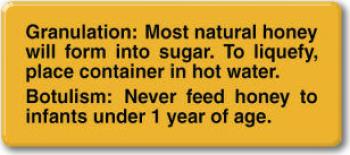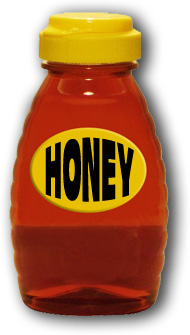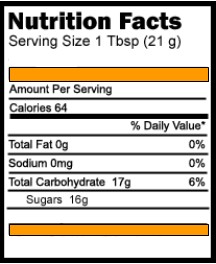Contact
Assistant Professor of Apiculture & Urban Entomology
Phone: 501-671-2222
Fax: 501-671-2252
Email: jzawislak@uada.edu
Web: uaex.uada.edu/bees
University of Arkansas System
Division of Agriculture
Cooperative Extension Service
2601 N. Young Ave.
Fayetteville, AR 72704
All About Honey
What is Honey?
Honey is the sweet golden liquid that beekeepers harvest from their hives of honey bees. It's pure and natural, delightful and delicious. It's liquid sunshine. Bees collect the nectar produced by flowers and store it in their hives to consume during winter or periods of drought. These industrious insects process the nectar by adding enzymes that chemically alter the sugar molecules, and by removing most of the moisture from the solution. The resulting product, honey, is thick and sweet, and will keep virtually forever without spoiling.
Strained Honey vs. Filtered Honey
Because the process of extracting honey from it's combs often results in small bits of wax falling into the honey, it is usually strained out before the honey is bottled. Beekeepers typically use strainers between 200-600 microns in size (0.008-0.024 inches in size). This removes most debris but easily allows honey to pass through, along with naturally occurring pollen grains, which range between 15-200 microns in size. Most honey is strained.
Many large bottling companies use fine filters to remove even the smallest grains of pollen and other tiny debris from honey. This is usually done to slow the process of crystallization, which occurs as sugar molecules latch onto larger particles in a particular arrangement. Because honey is very thick and viscous, it's usually heated, which makes it thinner and easier to pump through filtering machines. Heating honey, however, can destroy its natural enzymes, and it should no longer considered "raw" honey.
In some cases, unscrupulous suppliers have been known to filter all pollen from large shipments of honey. This has been used to disguise the honey's country of origin, which can be determined from the presence of regionally distinctive pollen species. This honey may also be adulterated with other cheap sweeteners, and even mixed with unfiltered honey from other places, to appear as if it were produced in another country. This process known as "honey laundering" has been used to circumvent national tariff laws, and has recently been the subject of several high profile investigations resulting in fines and prison sentences. There is a large market for cheap imported honey in the food processing industry, but unfortunately it is difficult for the USDA to screen the majority of imported honey supplies.
How can you be sure yours is a pure honest product? You can purchase honey directly from a local beekeeper! It may cost a little more than supermarket honey, but the taste alone is worth it. And you'll be helping your local economy while ensuring that your own neighborhood stays pollinated. You could also produce and sell your own pure delicious honey when you choose to keep your own honey bees.
Raw Honey vs. Organic Honey
Honey is a naturally pure and safe food. Because it has a high sugar content, mild acidity, and a low moisture level, microorganisms cannot grow in honey. It never needs pasteurization. Raw honey is essentially the same product that the bees have produced. It naturally contains enzymes, vitamins and grains of pollen. Raw honey is strained to remove impurities, such as wax, but is never heated excessively. Some commercial processors may heat honey to lower its viscosity and filter out pollen and other particles that promote crystallization. Excessive heating can destroy some of the natural enzymes.
The USDA-Organic seal on a product label indicates that it was produced without chemical pesticides, synthetic fertilizers, bioengineering or ionizing radiation. Honey labeled as "organic" indicates that it meets strict standards implemented by the USDA, through third-party certification agencies, whether produced in the US or in a foreign country. Because honey bees can forage so far from their hives, it is practically impossible to control whether they may come into contact with pesticides, fertilizers, or other substances prohibited under organic regulations. Most organic honey sold in the U.S. is therefore produced in other countries where pesticides are not as commonplace. An alternative certification, such as Certified Naturally Grown, indicates that the honey was produced using sustainable methods, and without employing chemical pesticides in or around the hives, while recognizing that bees may visit non-organic landscapes beyond a beekeeper's property lines.
Use of the term "organic" on a product label requires legal certification by an accredited agent. Other terms, such as raw, pure, or natural are not regulated by law, but should not be used in any manner to misrepresent the product to the consumer.
Crystallized honey
All natural honey will eventually crystallize. The rate at which it does do will vary with the nectar sources that the bees collected, and the ratio of glucose and fructose, the main sugars found in honey. Honey with a higher glucose content tends to crystallize more rapidly than honey with a higher ratio of fructose. Raw honey tends to crystallize more readily than processed honey because it contains more microscopic particles, such as pollen grains, which the crystals form around. Crystallized honey has not spoiled. Simply place the container in a pan of warm water (about 100°F) to liquify the honey again. If the honey has not become completely solid, you may still be able to use it. You can dissolve a spoonful into your tea or other beverage.
Sometimes honey is purposely made to crystalize in a specific way, which yield very small crystals, and remains soft enough to spread with a butter knife. This product is known as creamed honey or whipped honey, and is very popular in many parts of the world.
Can eating local honey provide relief from pollen allergies?
This is a very common question, and is supported by thousands of people who believe it to be true, because it seems to work for them. But is there any clinical evidence? A simple answer is complicated by many variables. No two people are alike, and one person's seasonal allergies are not necessarily the same as another's. Honey bees do collect and transport pollen grains from many flowering plants when foraging for nectar, and raw honey does include some traces of these pollens. Whether the amount of pollen present in a particular honey is sufficient to stimulate a human's immune response will depend on the individual. Honey collected within 25 miles could be considered "local" and is apt to contain many pollen types that would be found near one's home. However, consumers must also consider the time of year that the honey was collected, and what plants were in bloom. Will spring honey help to immunize a person who suffers from fall ragweed? Not necessarily, but ragweed is a member of the plant family Asteraceae, which also includes sunflowers, dandelions, daisies and thousands of other common flowers. Some of these species may be related closely enough to provide some cross-benefit to a honey consumer. These potential benefits may vary widely between individuals. Many anecdotal reports claim complete relief form allergies, however, for some hyper-sensitive individuals, consuming raw honey could potentially result in a severe allergic reaction. For more information, read Foster and Foster (2012) Evidence for the Use of Local Honey for the Relief of Pollen Allergies, American Bee Journal 152(10):961-964.

Why should honey not be fed to infants?
Infant botulism is a unique form of food poisoning caused by a bacterial toxins from the bacterium Clostridium botulinum. Children under twelve months of age may not have a strong enough immune system or sufficient stomach acids to fend off this form of bacterial spore. Although honey prevents the growth of bacteria due to its low pH and moisture level, honey may contain the spores of a bacteria called Clostridium botulinum. When a young child eats the this honey, bacterial spores could potentially activate and produce botulism food poisoning. Botulinum spores can also be found in inadequately prepared home preserves or canned goods, and can be common on unwashed fresh fruits and vegetables. Although the risk is very low, children should not be fed honey until they have reached one year of age to avoid potential food poisoning. This is why some honey labels feature a warning about feeding to infants.
Honey Sales
Honey and other fresh farm products can be sold from the site where the product is produced (the "farm"), or at farmer's markets, county fairs, and other special events. These products are to be sold directly from the producer to the consumer, and may not be sold wholesale without a valid permit from the Arkansas Department of Health.
Honey is considered a farm product, and is exempt from sale tax when sold direct-from-farm (this may include an urban beekeeper's home). A farmers' market or roadside stand is also considered an extension of direct-from-farm sales. For more information, see Ark. Code Ann. § 26-52-401(18)(A)(iii).
Bottling Your Honey
Honey is a wonderful, delicate, and naturally pure product. It should be packaged in such a manner that it maintains and shows off its fine qualities. Always use new, clean glass or plastic containers to bottle honey. There are many types of elegant and inexpensive containers sold by beekeeping supply companies. A variety of attractive pre-printed labels are also available.
The processing and packaging to food products in the Natural State is regulated by the Arkansas Department of Health. Honey hobbyist (producers of less than 500 gallons of honey per year for sale) are not required to be inspected by the Arkansas Department of Health. These operations are generally considered to be a low priority of the Environmental Health Specialists (EHS). Due to honey's low risk to the public, the limited size and scope of a hobbyist operation, and the limited number of impacted individuals, they are assessed only by the request of the producer. While the EHS does not actively seek out the honey hobbyists, if a hobbyist requests to be inspected, the EHS assists by supplying the proper plan review guidelines. After the permit process, the hobbyists are treated as any other food service establishment, and may be subject to ADH food processing rules and regulations and practices.
The Cottage Food Operations Act (Act 72 of 2011) allows a limited selection of foods to be prepared for sale in the home kitchen without a permit. The foods that are allowed under this act pose low risk of illness caused by hazardous bacteria. These include bakery items that do not require refrigeration, fruit butters,candy, jellies, jams, honey, sorghum, maple syrup, and raw fruits and vegetables. (Upon request, samples of products shall be made available to the Arkansas Department of Health.) Prepared foods that require temperature control for safety or to limit microorganism growth or toxin formation are not allowed for sale under this act. Product must be labeled with the name and address of the business, and must contain a list of ingredients. The label should include the statement "This Product is Home-Produced" in 10-point type.

Labeling your honey
In addition to the jar or bottle, the label you attach to your product should be appealing to your potential customers. When you package honey for sale, you must also meet certain legal requirements.
A label must indicate the common name of the product. In this case, the word "Honey" should be clearly visible on the label. If you are certain that your honey is primarily a monofloral variety, you may label it appropriately (i.e. "Clover Honey" or "Blackberry Honey").
The net weight of your product (excluding packaging) should be indicated in easy-to-read type, located on the lower third of the label. It must be listed in both pounds and ounces, and in metric weight (i.e. "Net Wt. 16 oz. (454 g)"). Use the government conversion factor of 1 oz. = 28.3495 grams. Most containers that are manufactured specifically for honey bottling indicate the weight of honey that they will hold. Other containers may be labeled by fluid ounces, which is different than weight. For example, a pint jar holds 16 fluid ounces, or approximately 1 pound of water, but holds 1.5 pounds of honey. If you are using a container of unknown volume, measure the volume of water it holds, and use the the online honey calculator to establish its net weight.

Honey Nutrition Information
One tablespoon of honey contains 64 Calories. By contrast, a tablespoon of sugar contains 45 Calories. However, honey tastes sweeter than sugar, and people tend to use less.
The exact makeup of each individual honey varies somewhat, but honey is generally composed of:
- 80% sugar (fructose & glucose)
- 18% water
- 2% minerals, vitamins, pollen & protein
Labels on packaged food must list the contact information for the packer. This includes the name and address of the person or company that packaged the product. If you purchase honey from another beekeeper and bottle it yourself, your contact information must appear on the label. A telephone number, email address or website may also be included. This information must be in a type size that is at least 1/16" tall.
Beekeepers making honey in the Natural State may apply for the Arkansas Grown branding program, to promote their product as locally produced, and to take advantage of promotions and advertising from the Arkansas Department of Agriculture.
For more information about honey labeling, visit the National Honey Board.
Learn more fascinating facts about honey (from the National Honey Board)
- How honey is made
- The forms of honey
- Honey color & flavor of honey varieties
- Honey's Natural Benefits